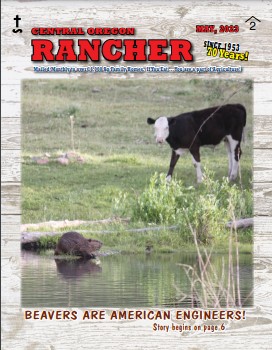Not long ago, water held longer on Oregon landscapes as beavers occupied streams through every corner of the state. Waters were slowed, valley bottom floors widened over time as sediment, and rich soils built up, which increased forageable areas. These stream flows remained throughout the year, even during severe drought.
All of this is thanks to the activities of an important American engineer: The beaver. Beaver activity in the West has dominated and shaped our lands for an estimated seven million years.
Written accounts of this lush landscape from 200 years ago by early European and American travelers describe something wholly different from today: “stirrup high grasses, wetted meadows, and beavers”. Since then, however, these conditions have collapsed due to the near eradication of beavers.
The 1820s started two decades of intense trapping by the Canadian Hudson Bay Company in order to create a “Fur Desert” in the Oregon Territories. Their goals in this endeavor were twofold. First, commerce – lucrative fur hats and castor. Second, political – to delay and deter American settlement.
But the settlers came anyway. Pioneering families carved out a living on these landscapes to create homesteads, operations, and communities where once there were none. After a time, trapping intensity had slowed, and beavers started to return, but problems caused by their activities around irrigation and production gave producers reason to keep removing them.
This continued absence of beaver dams, channels, and general activity, intensified flooding and erosion –breaking natural cycles while draining water from the land more quickly during snow melts and large rain events.
More recently though, there are a few places where beavers have been left alone to work in Oregon. Efforts by landowners, conservation districts, and watershed agencies to mimic beaver dams (known as Beaver Dam Analogs or “BDAs”) have kickstarted natural processes again. The result? Beavers are slowly returning to keep precious water on the land longer, all while rebuilding sediment, reducing flooding, and increasing water levels and forage later into the year.
All of this can happen with benefit to lands in production.
The Western beaver is truly an American engineer. Just like the successful return of our American Bald Eagle, beavers can return and shape the West once again.
Beaver Facts:
- Beaver activities help to slow waters, collect sediment, reduce erosion and increase forage
- A beaver pond can hold 5 times the amount of its water underground, then released later in the season
- A beaver family home base ‘territory’ is usually about ½ mile stretch of stream
- A beaver family needs about 3 to 5 acres of dense food (favorites are willow and cottonwood) in order to be successful
- Young, two-year old beavers leave their families in spring in order to setup new families of their own.
- Beaver populations are estimated at 5% to 10% of their historical numbers
